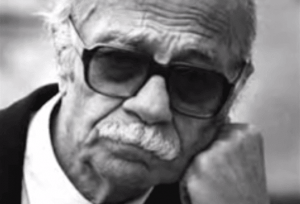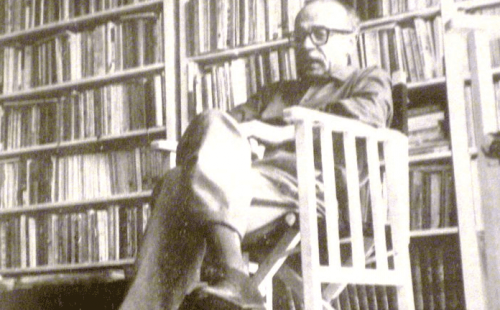Ernesto Sabato: An Argentinian Renaissance Man

Ernesto Sabato was an intellectual without borders. He captivated people with his writing and brilliant speeches. Although the world fell in love with the Argentinian author’s words, he also made a name for himself in other fields.
Sabato was a renaissance man who made important contributions to literature, science, and philosophy. The fact that he made his mark on every field he decided to explore speaks to his brilliance and creativity. We’re dedicating this article to Sabato’s life, his writing, and his multidisciplinary legacy.
“Living consists of building future memories.”
-Ernesto Sabato-

Sabato’s early years
Ernesto Sabato was born on June 24th, 1911 in Rojas, Argentina. He was born into an Italian middle-class family and he was the tenth child of eleven.
He spent most of his school years in Rojas, but then moved to La Plata to finish high school. He went on to study physics at the National University of La Plata. While he was there, he met his future wife, Matilde Kusminsky Richter.
In 1934, the Communist Party of Argentina sent Sabato to Moscow as a delegate. However, during his layover in Brussels, Sabato decided to escape. He fled to Paris, where he worked on his writing for a time. Then, he returned to Buenos Aires to get married.
In 1937, he got his doctorate in Physical Sciences and Mathematics from the National University of La Plata. From there, Sabato decided to continue his research in Paris. On May 25th, 1938, his first son, Jorge Federico, was born.
Just before World War II broke out, Sabato was transferred to Massachusetts. In 1940, he returned to Argentina to work as a professor at the National University of La Plata. He taught engineering and worked with post-graduate students on relativity and quantum mechanics.
The switch to writing
In 1943, he decided to leave the sciences and devote himself fully to art. He moved to a ranch in Córdoba with no running water or electricity and started writing. He collaborated with several magazines and also wrote reviews.
In the later part of his life, Sabato primarily dedicated himself to writing. However, tragedy struck the family when his son, Jorge Federico, died in a car accident in 1955. His wife died about forty years later in 1998. Sabato lived to be nearly 100 years old. He died from pneumonia on April 30th, 2011, just 55 days before his 100th birthday.
Ernesto Sabato, much more than a writer
Although the world knows Ernesto Sabato as a writer, as we mentioned above, he dabbled in many other fields during his lifetime. Here are some of his contributions to other disciplines:
- Politics. Sabato identified as a socialist for many years. In fact, the socialist party chose him to be a delegate. However, he later distanced himself from socialism in his writings and public appearances. Instead, he supported a society based on individual liberty, decentralization, and cooperation.
- Physics and math. Sabato received a grant to do research on atomic radiation at the Curie Laboratory in Paris. However, his encounter with surrealism in France prompted him to back away from scientific research.
- Painting. In 1970, Sabato felt he had already said everything he could say as a writer. In addition, vision problems forced him to quit reading and writing, which is why he immersed himself in the world of painting.
Ernesto Sabato was also very interested in philosophy. He valued knowledge and considered it the true source of human liberty. Sabato wrote several philosophical articles that were very critical of science. He argued that science, unlike philosophy, was dehumanizing.
When you look back on Sabato’s life, a common thread that ran through everything he did was a strong interest in social, cultural, and political subjects. This interest resulted in some very prestigious jobs, such as his position as director of UNESCO and the Foreign Affairs Ministry. He eventually resigned from both positions due to disagreements with the organizations.

Ernesto Sabato’s writing
As we’ve said above, focusing only on Sabato’s work as a writer would not do justice to his varied intellectual activity. However, critics and fans all over the world praise him for his written work. Here’s a quick summary of some of his most famous books:
- The Tunnel (1948). This psychological novel narrated in the first person immerses the reader in existentialism. The main character writes from prison about the reasons he committed murder. Although several publishers rejected The Tunnel, once it was finally published, critics, including important writers such as Albert Camus, gave it rave reviews.
- On Heroes and Tombs (1961). Ernesto Sabato wrote this novel when he was 50 years old. Many people consider it to be the best Argentinian novel of the 20th century. It narrates several storylines simultaneously, set in the context of Peronism. Although Sabato initially considered burning this manuscript, his wife convinced him to publish it.
- The Angel of Darkness (1974). This masterpiece is one of Sabato’s more experimental books. The apocalyptic plot is immersed in some of the important events in Argentina’s history on the backdrop of important 20th-century global events.
Articles and acclaim
Ernesto Sabato also published many articles, most of them philosophical. A few of his more political pieces stand out, such as “The Other Face of Peronism: Open Letter to Mario Amadeo”, in which he defends Evita Perón and her followers.
Many important and famous authors praised Sabato’s work and he was featured in many magazines and interviews. He also received awards for his writing, most notably:
- The Argentinian Writer’s Association Grand Prize.
- Best Foreign Novel (Paris).
- The Miguel de Cervantes Prize.
Without a doubt, Ernesto Sabato left his mark on the world. His exploration in philosophy, science, and politics made him an incomparable author. Hopefully, this article inspires you to make some space on your bookshelf for his wonderful books!
Ernesto Sabato was an intellectual without borders. He captivated people with his writing and brilliant speeches. Although the world fell in love with the Argentinian author’s words, he also made a name for himself in other fields.
Sabato was a renaissance man who made important contributions to literature, science, and philosophy. The fact that he made his mark on every field he decided to explore speaks to his brilliance and creativity. We’re dedicating this article to Sabato’s life, his writing, and his multidisciplinary legacy.
“Living consists of building future memories.”
-Ernesto Sabato-

Sabato’s early years
Ernesto Sabato was born on June 24th, 1911 in Rojas, Argentina. He was born into an Italian middle-class family and he was the tenth child of eleven.
He spent most of his school years in Rojas, but then moved to La Plata to finish high school. He went on to study physics at the National University of La Plata. While he was there, he met his future wife, Matilde Kusminsky Richter.
In 1934, the Communist Party of Argentina sent Sabato to Moscow as a delegate. However, during his layover in Brussels, Sabato decided to escape. He fled to Paris, where he worked on his writing for a time. Then, he returned to Buenos Aires to get married.
In 1937, he got his doctorate in Physical Sciences and Mathematics from the National University of La Plata. From there, Sabato decided to continue his research in Paris. On May 25th, 1938, his first son, Jorge Federico, was born.
Just before World War II broke out, Sabato was transferred to Massachusetts. In 1940, he returned to Argentina to work as a professor at the National University of La Plata. He taught engineering and worked with post-graduate students on relativity and quantum mechanics.
The switch to writing
In 1943, he decided to leave the sciences and devote himself fully to art. He moved to a ranch in Córdoba with no running water or electricity and started writing. He collaborated with several magazines and also wrote reviews.
In the later part of his life, Sabato primarily dedicated himself to writing. However, tragedy struck the family when his son, Jorge Federico, died in a car accident in 1955. His wife died about forty years later in 1998. Sabato lived to be nearly 100 years old. He died from pneumonia on April 30th, 2011, just 55 days before his 100th birthday.
Ernesto Sabato, much more than a writer
Although the world knows Ernesto Sabato as a writer, as we mentioned above, he dabbled in many other fields during his lifetime. Here are some of his contributions to other disciplines:
- Politics. Sabato identified as a socialist for many years. In fact, the socialist party chose him to be a delegate. However, he later distanced himself from socialism in his writings and public appearances. Instead, he supported a society based on individual liberty, decentralization, and cooperation.
- Physics and math. Sabato received a grant to do research on atomic radiation at the Curie Laboratory in Paris. However, his encounter with surrealism in France prompted him to back away from scientific research.
- Painting. In 1970, Sabato felt he had already said everything he could say as a writer. In addition, vision problems forced him to quit reading and writing, which is why he immersed himself in the world of painting.
Ernesto Sabato was also very interested in philosophy. He valued knowledge and considered it the true source of human liberty. Sabato wrote several philosophical articles that were very critical of science. He argued that science, unlike philosophy, was dehumanizing.
When you look back on Sabato’s life, a common thread that ran through everything he did was a strong interest in social, cultural, and political subjects. This interest resulted in some very prestigious jobs, such as his position as director of UNESCO and the Foreign Affairs Ministry. He eventually resigned from both positions due to disagreements with the organizations.

Ernesto Sabato’s writing
As we’ve said above, focusing only on Sabato’s work as a writer would not do justice to his varied intellectual activity. However, critics and fans all over the world praise him for his written work. Here’s a quick summary of some of his most famous books:
- The Tunnel (1948). This psychological novel narrated in the first person immerses the reader in existentialism. The main character writes from prison about the reasons he committed murder. Although several publishers rejected The Tunnel, once it was finally published, critics, including important writers such as Albert Camus, gave it rave reviews.
- On Heroes and Tombs (1961). Ernesto Sabato wrote this novel when he was 50 years old. Many people consider it to be the best Argentinian novel of the 20th century. It narrates several storylines simultaneously, set in the context of Peronism. Although Sabato initially considered burning this manuscript, his wife convinced him to publish it.
- The Angel of Darkness (1974). This masterpiece is one of Sabato’s more experimental books. The apocalyptic plot is immersed in some of the important events in Argentina’s history on the backdrop of important 20th-century global events.
Articles and acclaim
Ernesto Sabato also published many articles, most of them philosophical. A few of his more political pieces stand out, such as “The Other Face of Peronism: Open Letter to Mario Amadeo”, in which he defends Evita Perón and her followers.
Many important and famous authors praised Sabato’s work and he was featured in many magazines and interviews. He also received awards for his writing, most notably:
- The Argentinian Writer’s Association Grand Prize.
- Best Foreign Novel (Paris).
- The Miguel de Cervantes Prize.
Without a doubt, Ernesto Sabato left his mark on the world. His exploration in philosophy, science, and politics made him an incomparable author. Hopefully, this article inspires you to make some space on your bookshelf for his wonderful books!
All cited sources were thoroughly reviewed by our team to ensure their quality, reliability, currency, and validity. The bibliography of this article was considered reliable and of academic or scientific accuracy.
Sabato, E. (1998). Abaddón el exterminador. Sudamericana.
Constenla, J. (1997). Sábato, el hombre: una biografía. Seix Barral.
Sabato, E. (2004). Sobre héroes y tumbas. Fundación Biblioteca Ayacuch.
Sabato, E. (2008). El túnel. Ediciones Urano.
This text is provided for informational purposes only and does not replace consultation with a professional. If in doubt, consult your specialist.







